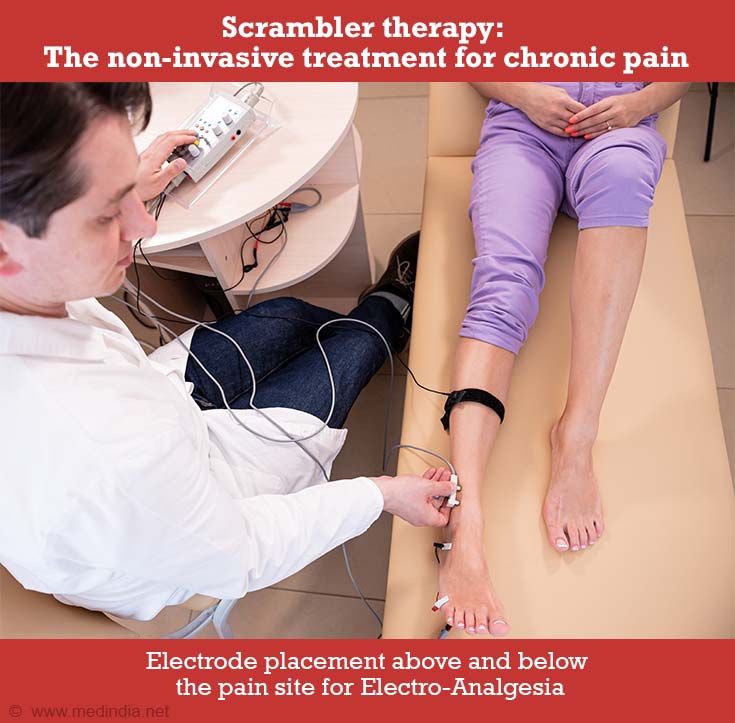- Scrambler Therapy - (https://hollingscancercenter.musc.edu/patient-care/patient-resources/scrambler-therapy)
- Scrambler Therapy May Offer Lasting Relief for Chronic Pain, Review Paper Suggests - (https://www.hopkinsmedicine.org/news/newsroom/news-releases/scrambler-therapy- may-offer-lasting-relief-for-chronic-pain-review-paper-suggests)
- Inside the Scrambler Therapy, a Noninvasive Treatment of Chronic Neuropathic and Cancer Pain: From the Gate Control Theory to the Active Principle of Information - (https://www.ncbi.nlm.nih.gov/pmc/articles/PMC6482660/)
- Scrambler Therapy for the management of chronic pain - (https://www.ncbi.nlm.nih.gov/pmc/articles/PMC4973603/)
About
Approved in 2009 by the US FDA, as a novel treatment therapy for refractory pain. Scrambler therapy is a non-invasive outpatient treatment modality for relieving chronic neuropathic pain. It has been approved and seen to be beneficial in a variety of chronic pain conditions like Chemotherapy-induced Peripheral Neuropathy (CIPN), Chronic cancer pain, Sciatic and Lumbar pain, Phantom limb syndrome, Post herpetic neuralgia (PHN), Post-surgical neuropathic pain and Chronic neuropathic pain(1✔ ✔Trusted Source
Scrambler Therapy
Go to source).
Scrambler Therapy: How does it Work?
Chronic pain is a debilitating condition, which is encountered by pain physicians. Though several pharmacologic and behavioral modalities for management of refractory chronic pain do exist, the treatment is often unsatisfactory.

Marketed by the Calmare™ therapy in the United States as the MC5-A Calmare scrambler therapy device, Scrambler therapy is a novel, non-invasive pain modifying technique that uses a rapidly alternating electrical impulse to send a "non-pain" signal along the pain pathway to the brain which were earlier receiving pain signals. The ultimate goal of the therapy is to replace signals from the area experiencing pain with signals coming from adjacent non painful areas, thereby "scrambling" the pain signals sent to the brain and re-organizing the maladaptive signaling pathways(2✔ ✔Trusted Source
Scrambler Therapy May Offer Lasting Relief for Chronic Pain, Review Paper Suggests
Go to source).
How is Scramblers Therapy Administered?
Scrambler therapy is administered by trained pain physicians and professionals who have undergone specialized technical training in the administrations of the therapy using the device and are well versed with the technique.
The therapy is administered by applying electrodes in areas of the body above and below where chronic pain is felt. Following application, electrical stimulation via low electrical impulses is applied through the skin. The treatment is usually given for 30-45 minutes consecutively for up to 10 days in a row over a two week period. Depending on the results of therapy, a patient may need few more sessions.
The end point to the treatment session is being able to completely eliminate the pain or reduce it significantly, without causing any significant discomfort to the patient(3✔ ✔Trusted Source
Inside the Scrambler Therapy, a Noninvasive Treatment of Chronic Neuropathic and Cancer Pain: From the Gate Control Theory to the Active Principle of Information
Go to source).
Pros and Cons of the Therapy
Research and several multi-centric trials stand testimony to the fact that Scrambler therapy is an effective method to combat chronic refractory neuropathic pain. It has the following benefits:
- Non-Invasive pain modulating therapy
- Reduced dependence on narcotics and other pharmacological preparations
- The procedure is pain free and the analgesia may last for weeks depending upon the patient’s response
Though benefits have been advocated in several studies, the therapy is not free from challenges:
- It is not a curative treatment. Several patients may require multiple sessions and despite that the effect may not be ever-lasting
- Anticonvulsants used for pain control, may inhibit Scrambler therapy effectiveness and are therefore recommended to be stopped prior to therapy treatments
- Drugs like Ketamine, Local anesthetics and muscle relaxants decrease the effectiveness of the therapy
- Minor side effects such as muscle weakness or hypotension may occur post therapy
Practical Considerations: Scrambler Therapy
- It is an operator dependent approach and different patients may experience different outcomes based on the technical expertise, understanding as well as the patient pain profile.
- It can be financially burdensome to advocate multiple sessions of the therapy when compared to other pharmacological treatment options.
- Implanted electrical devices, such as pacemakers, spinal cord stimulator or medication pump, are contraindicationsfor ST.
- Patients with significant psychiatric illness, traumatic brain injury and non- neuropathic pain are less likely to have good results with this therapy(4✔ ✔Trusted Source
Scrambler Therapy for the management of chronic pain
Go to source). It is of great importance that the benefits of Scrambler therapy can’t be over ruled. However further research and comparative trials are necessary to advocate its application for a larger population.
 MEDINDIA
MEDINDIA

 Email
Email







